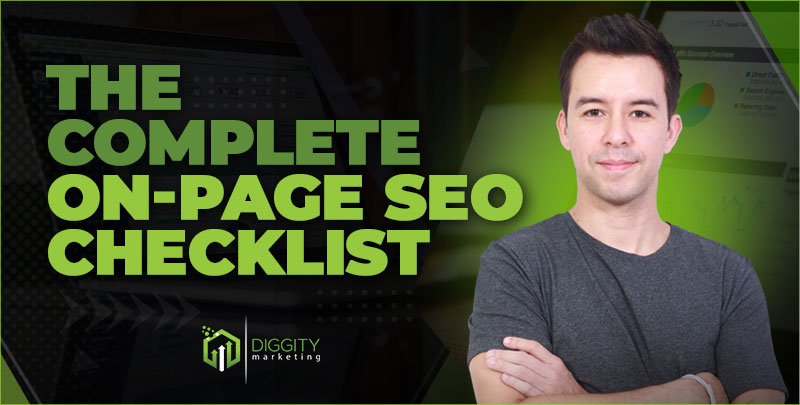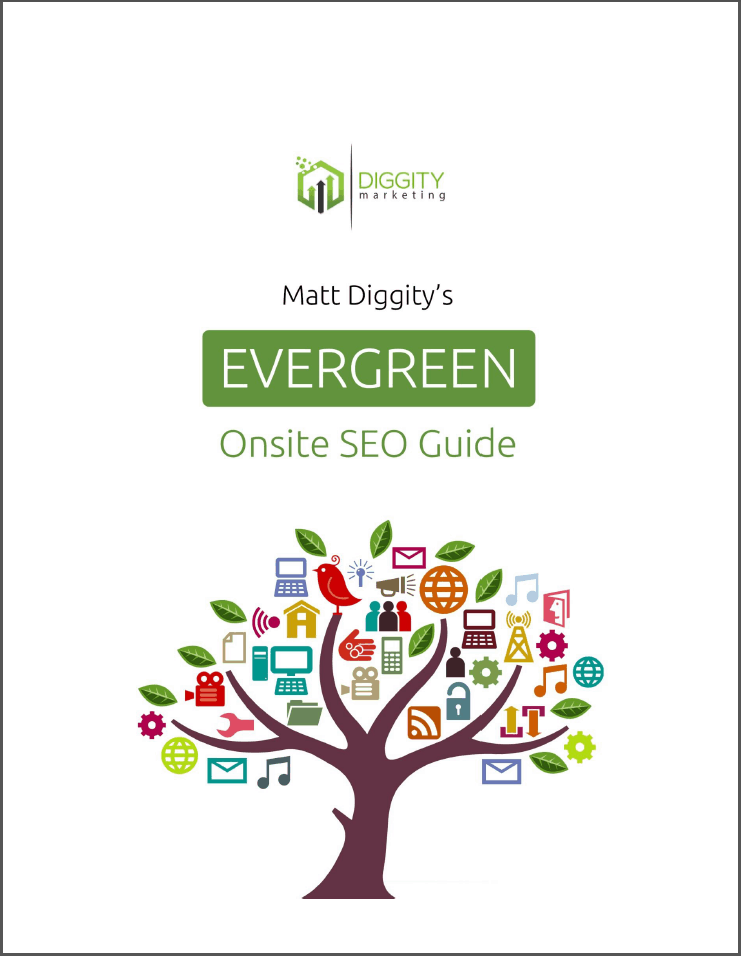As much as having great content, a sound technical foundation (i.e. having a mobile friendly website) and link building can get your site on the right track for SEO dominance, sometimes, it’s the little things that can make the biggest difference…
I’ve over a decade of experience in the SEO experience, and I understand the importance of optimizing on-page SEO elements for achieving search engine dominance.
Therefore, I’ve created the ultimate On Page SEO Checklist so that you can ensure that the primary elements of your site pages are well-optimized.
Table Of Contents
Quick Summary
On-Page SEO involves optimizing the core elements of a page such as the page titles, headings, meta descriptions, and images for the primary keyword that you want to rank for. These factors can significantly improve your site’s ability to rank and lead to more organic traffic.
An On-Page SEO Audit is crucial as it identifies issues with your content that could hurt user engagement and confuse the crawlers. Elements like page titles, URLs, headings, image alt texts, and internal linking need to be optimized to improve both user experience and search engine visibility.
While On-Page SEO is important, it should be complemented with a sound off page SEO, technical SEO foundation, and high-quality content. Other factors like structured data, identifying crawl errors, and content optimization also play a significant role in improving your site’s SEO performance.
What is an On Page SEO Audit?
Let’s get one thing straight, when I’m referring to “On Page SEO”, I’m not talking about optimizing content for reader retention or writing content to meet search intent – that’s for another article altogether.
Instead, I’m talking about optimizing the core elements of a web page such as the page titles, headings, meta descriptions and images on your website for the primary keyword that you want to rank for.
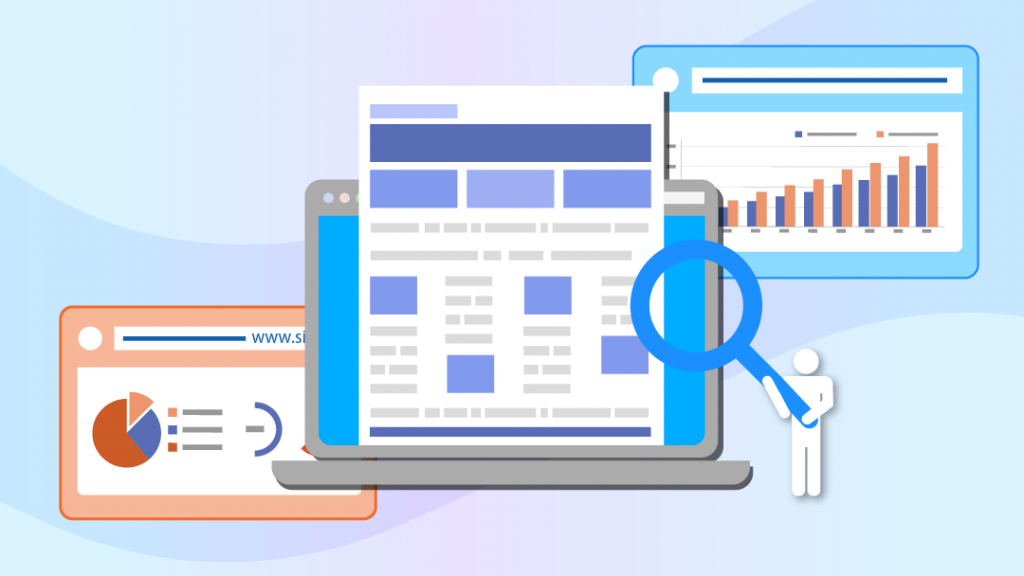
These are individual factors that can help improve your site’s ability to rank and lead to more organic traffic. For example, get your title and headings wrong, and it doesn’t matter if you’ve written the best piece of content, it’ll simply struggle to rank.
Why?
Because, an On Page SEO Audit also makes it easier for crawlers and human visitors to understand what the content is about without much effort.
Why are On Page SEO Audits Important?
An On Page SEO Audit is important because it can identify issues with your content that could hurt user engagement and confuse the crawlers. For example, unclear page titles that don’t include your primary keyword will decrease click-through rates, while also making it harder for the search engine bots to understand the purpose of your content.

Poorly-optimized URLs or the lack of headings will make your pages harder to navigate for both internet users and crawlers. If there are a lot of images on your website, but they lack the alt attribute, search engines won’t know what they depict.
Interlinking is another essential part of SEO that should be examined during an On Page SEO Audit. It is a way of showing Google which pages are to be considered the most valuable on your website. This can also help boost the rankings of individual pages and can make your website easier to navigate and improve user experience.
I’ll go through each of these elements in the On Page SEO checklist below.
On Page SEO Checklist
In order to make the most of this On Page SEO checklist, I highly recommend performing keyword research for your core landing pages.
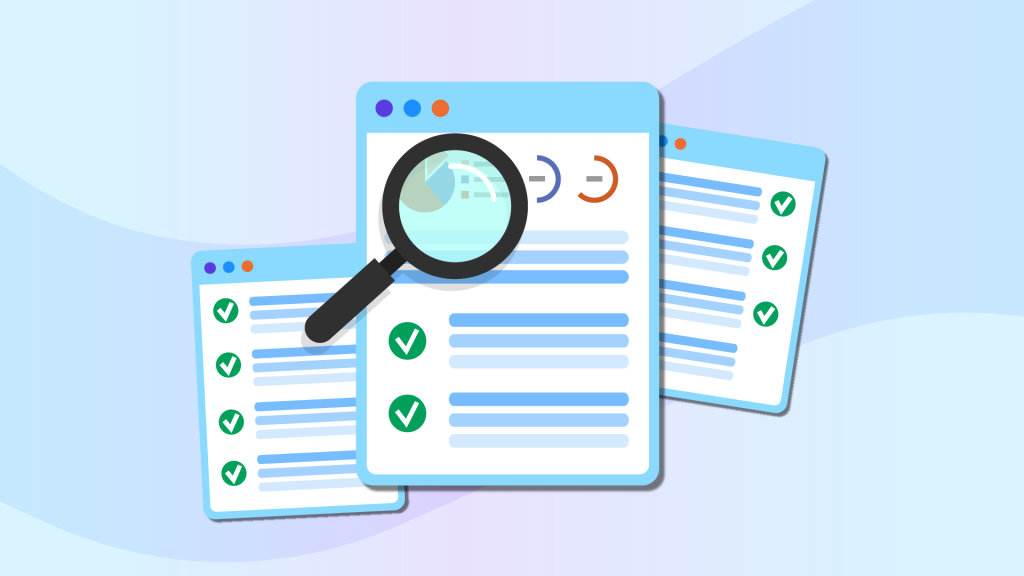
Taking this step will help make the next steps much easier to do as you’ll be able to identify the target keyword (or other search terms) for your pages.
Here are the SEO tools that you’ll need to complete your On Page SEO checklist:
 ScreamingFrog – Use ScreamingFrog (one of the best On Page SEO tools on the market) to crawl your website’s content and quickly generate reports for the below On Page elements.
ScreamingFrog – Use ScreamingFrog (one of the best On Page SEO tools on the market) to crawl your website’s content and quickly generate reports for the below On Page elements. On Page SEO Checklist Template
On Page SEO Checklist Template Ahrefs – This is one of the best SEO tools around. Ahrefs is a great tool for finding out how your competitors have optimized their on page SEO elements. Alternatively, you can use a simple Google search console for your primary keyword (or other search terms) to quickly see what the competition is doing with their on page elements.
Ahrefs – This is one of the best SEO tools around. Ahrefs is a great tool for finding out how your competitors have optimized their on page SEO elements. Alternatively, you can use a simple Google search console for your primary keyword (or other search terms) to quickly see what the competition is doing with their on page elements.
Page Title Optimization
What is a Page Title?
A page title (or title tag) is the HTML element that defines what the title of a web page is.
Here’s the title for The Search Initiative homepage in its raw HTML form:
<title>The Search Initiative - SEO Agency</title>Here’s how it appears in the search results:

And here’s how it appears in a browser’s tab:
![]()
Why Audit Your Page Titles?
Page titles are one of the Three Kings of On Page SEO with the other two being the URL and H1 heading. I’ll go into detail about URL optimization and H1 headings later on in this article, but for now, let’s take a look at why page titles are so important.
Page titles are a very important part of search engine optimization for both users and robots.
The title tag of your web pages is one of the first elements that users look at when deciding whether or not to click through to a page from their search. Well-written, engaging titles are known to increase click through rate (CTR) and engagement.

The main purpose of auditing your title tags is to ensure that they inform the audience (and search engines) what they can expect to find on your web page. They’re essentially a precursor for the main content on your site.
Page Title Audit Checklist
When auditing the page titles, you should ensure that they are:
Compelling and engaging – Page titles should grab the searcher’s attention and compel them to click through, but using ALL CAPS isn’t advised as it takes up too much space.
Short, sweet, and descriptive – According to Google, page titles should provide a “quick insight into the content of a result and why it’s relevant to their query”.
Unique – You should have “distinct, descriptive titles for each page on your site”.
Not too long – Google has a maximum width of 600 pixels for page titles. Page titles that exceed this will not be displayed in full. You should “avoid unnecessarily long or verbose titles”.

Optimized for your primary keyword – Whilst it’s not essential for page titles to include an exact-match for your target keywords, it’s good practice to do so. Just make sure that the title tag makes sense, is written in plain English with the end-user in mind as opposed to search engines, and doesn’t include keyword stuffing.
Avoid page titles like this that are over-optimized:
Cheap Holidays and Cheap Trips to New York | Book Cheap Flights Today
Instead, aim for page titles like this:
Book Cheap Holidays & Flights to New York Today | Tripster
Add your primary keyword towards the front – Adding your primary keyword phrase in a string at the front of your page title is recommended as users tend to skim through the search results to find what they’re looking for. It also helps build topical relevance in Google’s eyes.
Heading Optimization
What is a Heading?
Headings (aka header tags) are used to convey the hierarchy and structural outline of the content on a page to search engines and users.
There are six kinds of HTML Header levels where the H1 tag is the largest and the H6 tag is the smallest.
Here’s an example of a heading hierarchy
<h1> This is a H1 heading </h1>
<h2> This a H2 heading </h2>
<h2> This a H2 heading </h2>
<h3> This a H3 heading </h3>
<h2> This a H2 heading </h2>Here’s what the headings would look like:
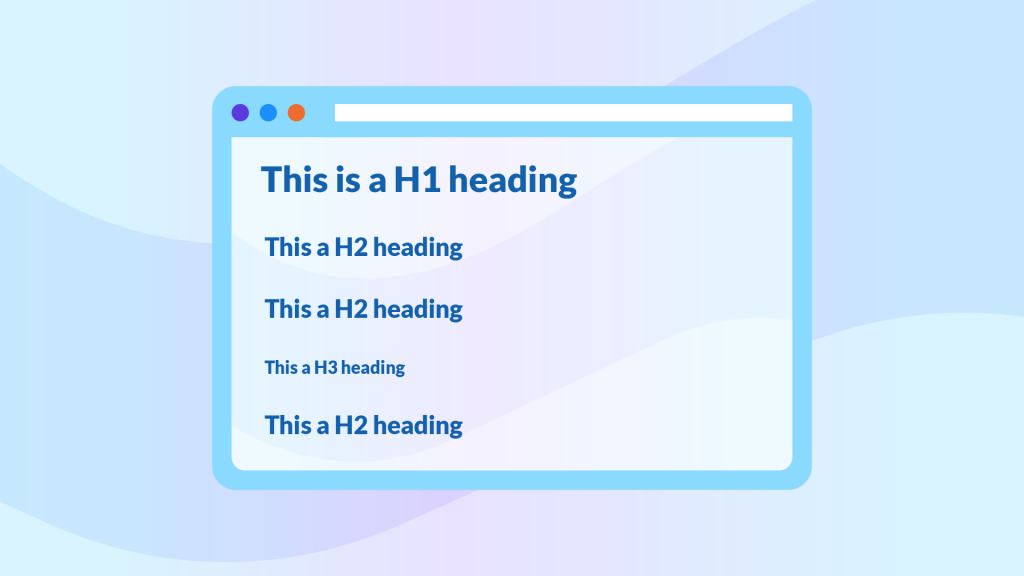
Why Should You Audit Your Headings?
Breaking up your content with headings makes it much easier for users to navigate through your page and find what they’re looking for.
Likewise, from an On Page SEO point of view, headings provide better context for search engines as they’re able to understand the hierarchy and structure.
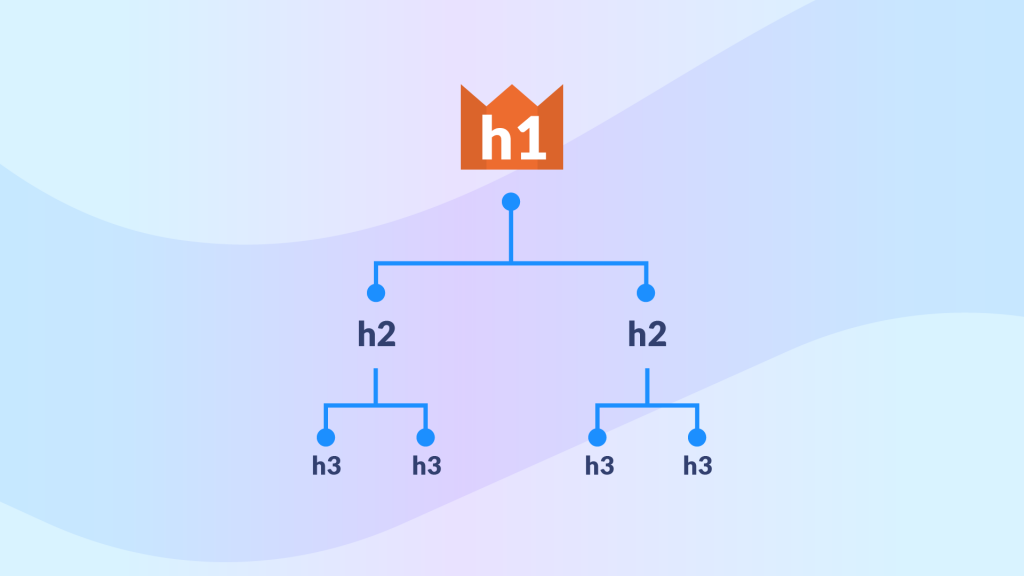
Aside from this, they may also aid your chances of appearing in the Featured Snippets.
Here’s an example for the keyword “how is vanilla extract made”.
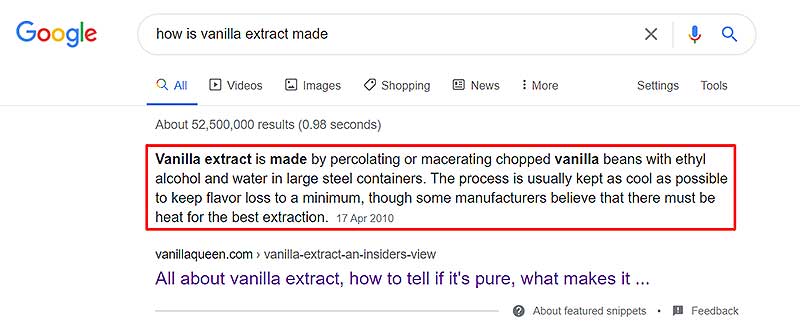
Let’s see where the featured snippet text is taken from…

Importantly, notice that the heading is exactly the same as our search intent query.
H1 Heading Audit Checklist
When auditing the H1 headings on your site, ensure that:
You only have one H1 tag – Although John Mueller says you can use “as many as you want”, I recommend using just the one H1 heading that is unique from the title tag as its primary purpose is to encapsulate what the page is about.
Your heading describes what your page is about – This should come as no surprise, but it’s important that your H1 heading summarizes the topics that you cover in the rest of the content on the page.
They aren’t too long – There’s no limit to how long an H1 heading should be, but it’s important to keep an eye on length as H1s that are excessively long become difficult to read. As a general rule of thumb, keep your heading shorter than 65 characters.
They aren’t too short either – H1 headings that are too short aren’t advised as they don’t offer as much value in terms of conveying what the user can expect from the page. As a general rule of thumb, keep your heading long enough to make sense.
They grab the user’s attention – The H1 tag will likely be what the user sees first, so it needs to grab the user’s attention and compel them to stay on your page.
Address the user’s search intent – If the heading doesn’t align with what the user is searching for from their query, they’ll simply leave.
Try to include the primary keyword you want to target – Although it’s not essential that your H1 heading include your target keywords, it’s good practice to do so as Google uses the H1 tag to understand the page’s topical relevance.
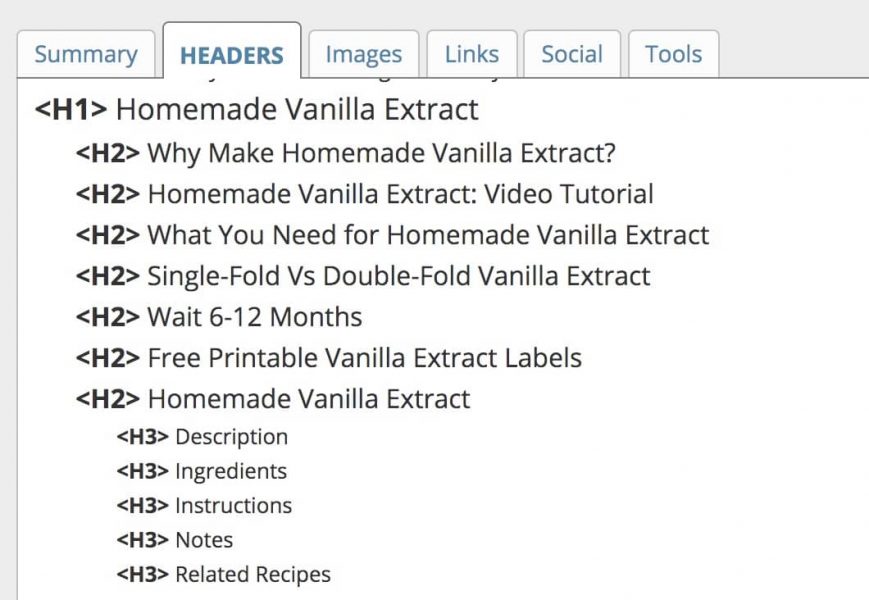
H2-H6 Heading Audit Checklist
When auditing the remaining headings on your website (primarily H2 headings), ensure that they:
Are meaningful – Google recommends using headers sparingly as having too many makes it difficult for users to scan the content.
Include long-tail keywords – Again, not all headings have to be optimized for your primary keyword, but sneaking long-tail terms into your headings can further improve Google’s understanding of the page’s context.
Answer subtopics required to answer the main search query – For example, it’s likely that users searching for a broad topic like “how to lose belly fat” will also want to know about things like “avoid trans fat” or “get exercise” etc. You can spot which subheadings to use by looking at your competition on page one of the search results.
Meta Description Optimization
What is are Meta Descriptions?
The meta descriptions summarizes the main content on your web pages is about in one or two sentences.
Here’s an example:
<meta name="description" content="This is a meta description">Why Should You Audit Your Meta Descriptions?
Despite the fact that they are not a ranking factor, meta descriptions should still be given importance because Google often displays them as part of the search results.

If you’re still not convinced, take it from Google, who say that they should “generally inform and interest users with a short, relevant summary of what a particular page is about. They are like a pitch that convinces the user that the page is exactly what they’re looking for”.
Essentially, this means that well-written descriptions may be the deciding factor as to whether or not a user clicks through to your website or not.
Moreover, if you include your primary keyword or other search terms within your descriptions, then Google will bold any words from the keyword within the search results.
For example, if our target keyword is “ruby chocolate”, then you can see that Google highlights all instances of the term within the results.
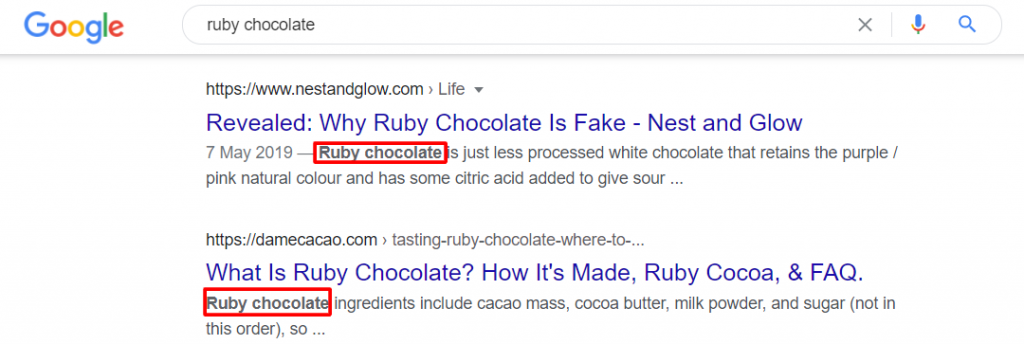
Meta Description Audit Checklist
During the auditing process, you should ensure that your descriptions:
Accurately summarizes your content – Your descriptions should encapsulate what the end-user will find on the page.
Are unique – “Identical or similar descriptions on every page of a site aren’t helpful when individual pages appear in the web results”, according to Google.
Are optimized with your primary keyword – Keywords from the user’s search may be highlighted in bold by Google in the search results which can help improve the click through rate (CTR) and reduce the bounce rate.

Are engaging – Your descriptions should engage the user but shouldn’t come across as clickbait.
Aren’t too long – As with pages titles, Google truncates descriptions that are too long in the search results. A general rule of thumb is to make sure that your descriptions are between 50–160 characters.

URL Optimization
What is a URL?
A URL (Uniform Resource Locator), is the unique address of any resource on the Web.
Why Should You Audit & Optimize Your URLs?
You should audit and optimize your URLs because this is one of the things Google recommends you do in their SEO Starter Kit.
The article recommends using simple, friendly URLs.
This is because the URLs of your site are usually one of the first things that both users and search engines will see.
URL Audit Checklist
When auditing/optimizing the URLs on your site, you should ensure that they are:
User-friendly first, then search engine-friendly – Your URLs should convey the main information about the content to the user in the simplest terms possible.
This not only makes it easier for users (and search engines) to understand what your post is about, but it also makes it much easier for other sites to link to you.
Avoid URLs like this: https://cycling.com/unicycle/red-2192734i.html
They come across as unnatural, confusing, and unfriendly.
A more meaningful and user-friendly URL would be: https://cycling.com/unicycle/red/
After making your URLs user-friendly, you’ll want to make them SEO-friendly too, which I’ll explain in the following points.
Concise – URLs should offer a quick insight into what users and search engines will find in your content.
For example, https://bestrouters.com/buy-wireless-routers/ could be shortened to https://bestrouters.com/wireless/
Punctuated correctly – Avoid using underscores (_) or spaces ( ) as separators for the words in your URLs.
Instead, use hyphens (-).
You want URLs like this: https://cycling.com/best-unicyles-under-300/
Instead of: https://cycling.com/best_unicycles_under_300

Consistent – It’s good practice to ensure that your URLs all follow the same structure. As mentioned above,
Here’s what a standard optimized URL structure would look like:

Avoid repeating keywords – try to avoid repeating keywords in your URLs. This adds little On Page SEO value especially as including keywords within your URLs isn’t that important according to John Mueller.
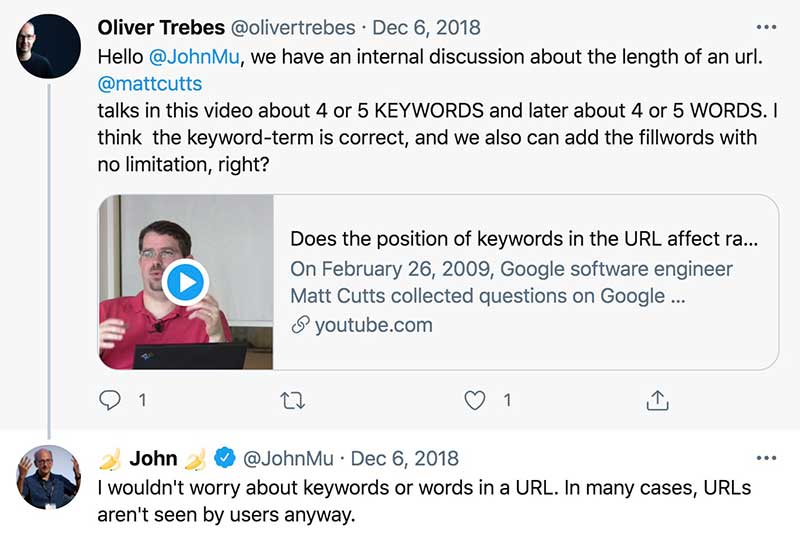
For example: https://bestrouters.com/wireless/ is better than https://bestrouters.com/wireless-routers/
Image Optimization
What is Alt Text?
The Alt Text (or alt attribute/alt tag) of an image is the HTML element used to textually describe an image on the Web.
Here’s an example of an alt tag:
<img src="my-image.jpg" alt="This is an image.">Why Should You Audit & Optimize Alt Tags?
Apart from improving your website’s accessibility and enhancing the experience for visually impaired users, there are also On Page SEO benefits to auditing and optimizing the image alt attributes on your site.
Search engines can’t “see” the images on a post, so they rely on the alt attribute along with computer vision algorithms, to help them understand what’s being depicted on an image.
In addition, they provide another opportunity for you to include the primary keyword that you might be targeting for that URL.
For example, let’s take the following image of a bike.

Whilst Google’s computer vision algorithms may be smart enough to decipher that this image features a bicycle, it perhaps won’t know that this is a mountain bike, or that the seats are made from leather.
Therefore, to give Google a little hand, you’d set the image alt attribute to something like:
<img src="peugot-mountain-bike.jpg" alt="A gray Peugeot mountain bike with brown leather seats.">Notice that the image file name is also descriptive and gives Google another hint as to what the image depicts.
Finally, optimizing and auditing the images on your site is also beneficial in increasing your chances of them appearing in Google Image Search results.
Image Alt Text Checklist
During the auditing process, you should ensure that your alt tags are:
Descriptive – you should provide enough information to allow users and search engines to understand what’s in the image.
Not too long – Screen readers for visually impaired users tend to cut off around the 125 character point, so make sure that they aren’t excessively long.
Optimized for your keywords – Although this isn’t essential, it’s good practice to include your core terms within the alt tag as naturally as possible. This helps Google’s understanding of the image and the web page as a whole.
Internal Linking
The way Google traverses the World Wide Web is via links. Therefore, adding links to relevant resources internally is incredibly important for On Page SEO.
What is Internal Linking?
Internal linking is where one page links to another page on the same domain.

For example, if you had an online store that sold pet products, you may add a link from a blog post about Dog Grooming Tips to another post about Dog Shampoo.
Why Should You Audit Your Internal Links?
Auditing this on page element is important because as mentioned above, Google uses external links to discover (and index) new content on the Web.
So, imagine that you’ve just published a brand new blog post that you’re extremely proud of and can’t wait to see it climb up the search results.
However, it doesn’t rank.
Why? Because there are no links pointing towards it from elsewhere on your site, which means that Google is unable to crawl/index it.
In addition, adding these links specifically helps improve the flow of PageRank on your site. When done correctly and strategically, pages with more links pointing towards them from other pages on the site are likely to have a higher PageRank.
Take it from Google – “The number of internal links pointing to a page is a signal to search engines about the relative importance of that page”.
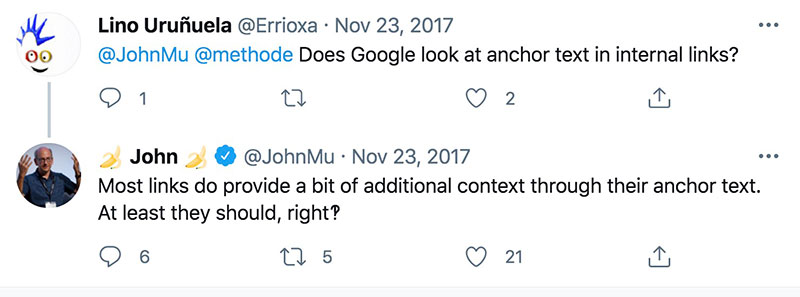
John Mueller also confirmed that Google uses the anchor texts to “provide a bit of additional context”. This is something that is becoming increasingly important as Google’s algorithms try to derive as much topical information about a web page as possible in order to deliver the best possible results for a user’s search query.
Internal Linking Audit Checklist
During the auditing process, you should look out for the following:
Identify Orphan Pages – These are pages that don’t have a single link pointing towards them from other pages on the site and as a result, Google will not be able to find and index them.
Fix Redirected / Broken Links – These are pages that link to other pages on your site that perhaps no longer exist (i.e. they return a 404 error code) or have been redirected to a new URL. If you have any broken links, you should try to add them back in so that you don’t waste any precious PageRank and avoid any On Page SEO issues
Relevance – Ensure that the pages that you are linking to internally, are relevant and appropriate for that particular page.
For example, categories and subcategories can link to each other as long as they are related.
In this article for Turntables Under $500, you can see that the site has added links pointing to their blog as well as a general Turntable Buying Guide within their article.

Anchor Text – Evaluate the anchor texts used and ensure that they are descriptive and informative so that Google gets a better understanding of the relationship between these pages and builds more topical relevance.
A diverse, keyword rich anchor text distribution that also includes branded (i.e. The Search Initiative), URL (i.e. thesearchinititatice.com) based, and generic (i.e. click here) anchor text is recommended.
Internal Links to Unimportant Pages – When filtering through the results from your site crawl, you can sort the Internal Links report by the number of links pointing towards each page. If you find that unimportant pages have too many links, remove them. Your most important pages should have the most internal pages linking towards them.
Internal Link Position – Avoid bunching links together at the top or bottom of your pages. Instead, make sure that they are evenly spaced out throughout your content.
Schema Markup
Schema markup, also known as structured data, is a powerful SEO tool that often flies under the radar. It’s like a secret handshake with search engines, giving them direct information about your content and how it should be displayed in search results.
What is Schema Markup?
Schema markup is a form of microdata that adds a rich layer of context to your website’s content, making it more understandable for search engines. It’s a code that you put on your website to help search engines return more informative results for users.
For instance, if you’ve ever seen a SERP entry with star ratings, a product price, or an event date, you’ve seen the power of schema markup in action. These enhanced descriptions, known as rich snippets, are a result of a website using schema markup.
Why is Schema Markup Important?
Schema markup is important because it can significantly improve your visibility on SERPs. By providing search engines with additional information, you can help ensure that your content is displayed in a way that is most relevant to users. This can lead to increased click-through rates and improved SEO performance.
Moreover, schema markup is a key part of Google’s future with the rise of voice search and Google Assistant. It’s the foundation for a machine-readable web and is used to generate rich snippets and power various SERP features such as:
Product information for eCommerce sites
Ratings and reviews
Local business information
Event details
Recipe cooking times
FAQ sections
Implementing schema markup involves adding specific attributes to the HTML code of your web pages. There are various types of schema markups available depending on the type of content you’re dealing with. For instance, you can use:
Article schema for blog posts and news articles
Product and Offer schemas for product pages
Review schema for customer reviews
LocalBusiness schema for local business information
Event schema for event details
To implement schema markup, you can use Google’s Structured Data Markup Helper or JSON-LD, a lightweight linked data format that is easy for humans to read and write.
Schema Markup Audit Checklist
Identify Important Page Types: Identify the types of pages on your site that could benefit from schema markup. This could include product pages, blog posts, event pages, recipes, etc.
Markup Implementation: Check if there’s existing schema markup on your site. You can do this by inspecting the HTML code or using Google’s Structured Data Testing Tool.
Markup Type: Evaluate if the correct type of schema markup is being used. For example, a product page should use Product schema, a recipe should use Recipe schema, etc.
Required Properties: Check if all required properties for each schema type are included. For example, the Product schema requires “name” and “image” at minimum.
Optional Properties: Determine if optional properties that could provide On Page SEO benefits are being used. These can help make your snippet more appealing or informative.
Property Accuracy: Ensure that the content of properties is accurate. The markup should correctly represent the content of the page.
JSON-LD Implementation: Check if the schema markup is implemented in JSON-LD format. This is Google’s recommended format.
Markup Position: Schema markup should be placed inside the <head> tag of the HTML or in the body where the information is visible to the user.
Multiple Item Markup: If a page contains multiple items (like multiple blog posts on an archive page), check that each item has its own schema markup.
Markup Consistency: Check if the schema markup is consistent across similar pages. For example, all product pages should have similar markup.
Local Business Schema: If you are a local business, ensure that your local business schema markup is correctly implemented with all necessary properties.
Social Media Schema: Check if you have correctly implemented social media schema to link your website with your social media profiles.
Don’t Forget the Other Cornerstones of SEO!
As much as this article is focused on optimizing on page elements, remember that your focus should primarily be on ensuring that your Technical SEO is sound and that the content that you provide is the best it can be.
These are the factors that will truly affect your site’s rankability whereas the on page elements mentioned in this article, will help move the needle in the right direction.
Technical SEO
No SEO audit is complete without looking at the technical SEO aspects of your website.
This includes making sure that your URLs are discoverable by Google (and other search engine bots) so that they can be indexed. Without identifying crawl errors, your content won’t be discovered and will not rank.
In addition to this, you also need to make sure your site loads quickly for both mobile and desktop visitors. If your site isn’t mobile-friendly, users will get frustrated and leave your site.Auditing other technical SEO factors such as structured data (or schema markup), JavaScript SEO and server log analysis are all beneficial for improving your site’s search visibility.
You can find out how to conduct a thorough Technical SEO audit via this checklist where I show you how to audit each of these elements using tools like Google Search Console and Pagespeed Insights.
Content Optimization
Earlier on I highlighted that On Page SEO isn’t necessarily the same as content optimization.
Content Optimization is about ensuring that your content is optimized for the keywords that you want to rank for.
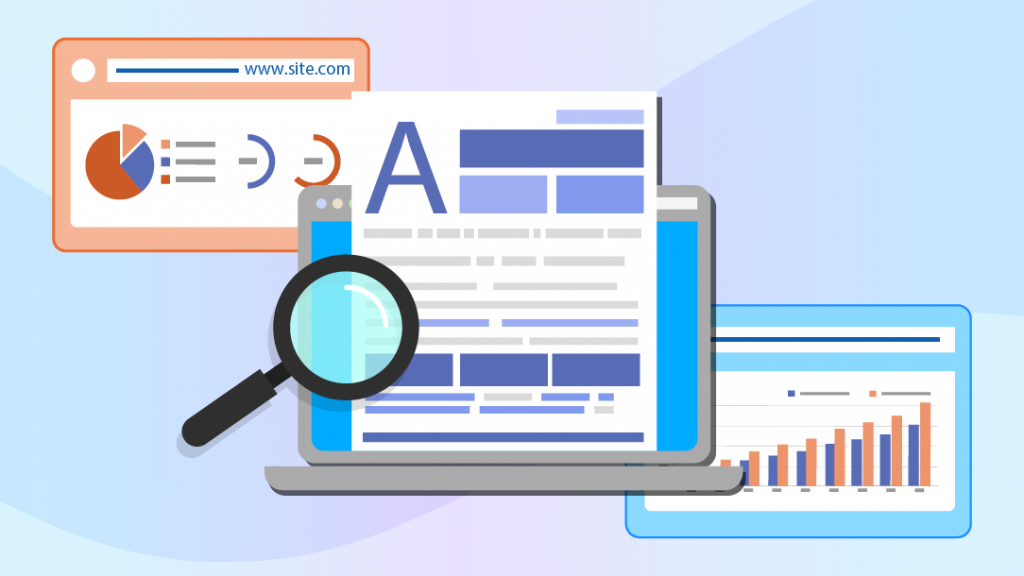
This involves optimizing the readability of the text (i.e. how easy is it for both users and search engines to understand the content?) by using short, simple sentences. Content optimization also relates to keeping your content up to date, especially if you are writing about topics that are time-sensitive.
These are all factors that I cover in our SEO Content Audit and Checklist.
FAQs
What Is On-Page SEO With Example?
On-Page SEO involves optimizing web page elements to improve search engine rankings and attract organic traffic. For example, if you’re targeting the keyword “best coffee shops,” you’d include this keyword in your page title, meta description, and throughout your content.
Additionally, you’d ensure your website is mobile-friendly and loads quickly to provide a good user experience.
What Are the 3 Most Important Things for On-Page SEO?
The three most important things for On-Page SEO are keyword optimization, content quality, and user experience. Keyword optimization involves using relevant keywords in titles, headings, and meta descriptions.
Content quality refers to providing valuable, unique, and engaging content. User experience includes factors like page load speed, mobile-friendliness, and easy navigation.
How to Do an On-Page SEO Analysis?
To do an On-Page SEO analysis, start by identifying your target keywords. Then, evaluate how well these keywords are integrated into your page titles, headings, and content.
Check the quality and relevance of your content. Finally, assess the user experience by looking at factors like page load speed, mobile optimization, and site navigation.
The Bottom Line
With this On Page SEO checklist, you’ll be ensuring that each of the on page elements of your site are SEO friendly and optimized for Google. Just remember to have your keyword research at hand first as this will make things much easier for you.
I’ve said it once before and I’ll say it again – sometimes the simplest and smallest of tweaks can help make the difference in your site’s SEO performance. A website that ranks well, not only has great content, but each page will have a well-crafted title tag, headings, meta tags and URLs.
So it’s not all about structured data (aka schema markup), identifying crawl errors or optimizing content alone – these seemingly trivial elements are also worth your time and effort.
By following the steps I’ve outlined in this On Page SEO checklist, you’ll be able to move the needle of your core landing pages and blog posts too.
Ask yourself: is my website’s On Page SEO on point? If not, you now know what to do… you need to do an On Page SEO Audit!
